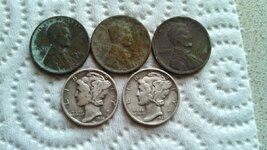ggossage
Hero Member
Spent most of the day in a well-hunted park and focused on two areas: 1) deep targets surrounded by moderate amount of bottlecaps and 2) 5-6 inch targets in a sea of bottlecaps. I scored two dimes and two pennies in area #2; the remaining penny was found in area #1. In area two, I enabled XY Vis and was able to scoot across the ground a little faster, and was very helpful in eliminating obvious trash. I got some pretty clear/straight lines on the coins I dug. I know I shouldn't rely on it, but it was helpful. Hope to see it more accessible in a future release.
Since this was my first day out with the Deus, I promptly disregarded all sage advice about using a preset
I settled on 4K for most of the hunt; it was much quieter and I was better able to identify all those deep-ish, old, rusty bottlecaps. I definitely figured out the sound difference between the coins I found and the bottlecaps....but that it took a while, and I dug plenty of 'em. I'm not sure I could distinguish between them and a quarter though. Every single coin I dug today either had a bottlecap or a nail in the same hole, and close by and consequently they brought the TID (VDI) down some. All coins were in the 60s before being uncovered and then changed to their normal reading above ground.
I used the following settings because of the caps:
Disc 5
4K (TX 3)
React 3 / Silencer 2
Notch 00-25
Sens 83
Sound 2
Iron Vol 2
Manual GB 78
5 tones
The park I was in was low mineralization, so I kept the GB low and sens lower.
A few questions if anyone has the time to respond:
If one uses pump to GB, after it's complete, is it supposed to revert back to manual? (When complete, the highlight bar goes to manual GB).
When saving a program, does it take an unusually hard press of the button to answer yes to replace the previous program? It often took me 2 or 3 times to get it to save...and even made the mistake of holding the button down too long and powered off the remote. Right now I'm only using the plastic protector that came with the remote.
I use the WS-5 headphones; I like them. However when I pulled them off today, one of the cups fell off and looks as though it'd be easy to do it again. Anyone had to fasten that down some how?
Coming from a White's machine, it's taking a lot of getting used to in order to avoid large iron at depth. I didn't use the pinpointer--maybe I should?
Since this was my first day out with the Deus, I promptly disregarded all sage advice about using a preset

I settled on 4K for most of the hunt; it was much quieter and I was better able to identify all those deep-ish, old, rusty bottlecaps. I definitely figured out the sound difference between the coins I found and the bottlecaps....but that it took a while, and I dug plenty of 'em. I'm not sure I could distinguish between them and a quarter though. Every single coin I dug today either had a bottlecap or a nail in the same hole, and close by and consequently they brought the TID (VDI) down some. All coins were in the 60s before being uncovered and then changed to their normal reading above ground.
I used the following settings because of the caps:
Disc 5
4K (TX 3)
React 3 / Silencer 2
Notch 00-25
Sens 83
Sound 2
Iron Vol 2
Manual GB 78
5 tones
The park I was in was low mineralization, so I kept the GB low and sens lower.
A few questions if anyone has the time to respond:
If one uses pump to GB, after it's complete, is it supposed to revert back to manual? (When complete, the highlight bar goes to manual GB).
When saving a program, does it take an unusually hard press of the button to answer yes to replace the previous program? It often took me 2 or 3 times to get it to save...and even made the mistake of holding the button down too long and powered off the remote. Right now I'm only using the plastic protector that came with the remote.
I use the WS-5 headphones; I like them. However when I pulled them off today, one of the cups fell off and looks as though it'd be easy to do it again. Anyone had to fasten that down some how?
Coming from a White's machine, it's taking a lot of getting used to in order to avoid large iron at depth. I didn't use the pinpointer--maybe I should?









